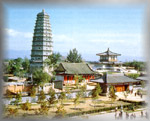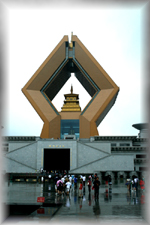the HIDDEN TREASURE
of FAMEN Si
EARLIEST TIMES
site
map
compiled from various sources by Footprints
 As
you drive west from Xian you pass through fertile lands. This is part of the
great loess plateau-country of northern China created by the dust of
ground-down mountains far to the west. It has been blown for millenia to form
a layer of special soil, loess, in places hundreds of feet
thick.
As
you drive west from Xian you pass through fertile lands. This is part of the
great loess plateau-country of northern China created by the dust of
ground-down mountains far to the west. It has been blown for millenia to form
a layer of special soil, loess, in places hundreds of feet
thick.
 This
region is the cradle of Chinese civilization. It was here that Late Stone Age
people began to develop the culture that evolved into the Chinese civilization.
When irrigated, these loess soils are some of the most fertile soil in the world
and are highly erodable. Although the climate has never been benign it was a
desirable place to live.
This
region is the cradle of Chinese civilization. It was here that Late Stone Age
people began to develop the culture that evolved into the Chinese civilization.
When irrigated, these loess soils are some of the most fertile soil in the world
and are highly erodable. Although the climate has never been benign it was a
desirable place to live.
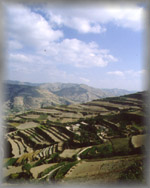 Five thousand years of farming has crafted a landscape of terraced fields which
rise in ranks to the summit of every hill. They are dissected by deep ravines
and nowadays peppered with red-tiled villages. It is pretty country.
Five thousand years of farming has crafted a landscape of terraced fields which
rise in ranks to the summit of every hill. They are dissected by deep ravines
and nowadays peppered with red-tiled villages. It is pretty country.
It is the valley of the Wei, the largest tributary of the Hu (Yellow) river.
In the 3rd century BCE the Chin dynasty created a large and efficient irrigation
system, based around two large canals at the junction of the Ching and Wei rivers.
This system, watered some 180,000 hectares and provided the powerful economic
base for the Ch'in's eventual conquest of the whole of China and helped provide
the labour for construction of the Great Wall.
When the Han dynasty dissolved in 9 CE a long period of disunity followed.
Around the 4th century a group of Turkic tribesmen, the Toba, moved into this
region. They conquered the small weak north China states and assumed for themselves
the ancient name of Wei. By 439, the Northern Wei had secured their territories
from attack and unified all of North China.
As so often happened in Chinese history the conquerors became seduced by Chinese
luxury. Impressed by the aristocratic style and aura of distinction of Chinese
nobles many families, including the imperial house, adopted Chinese surnames
and endeavoured to rewrite history by disowning anything relating to their non-Chinese
origins. Their enthusiastic adoption of Buddhism led to a backlash with suppression
off monasteries and full scale persecution only to be followed by an emperor
who reversed these trends.
The greatest cultural contribution of the Wei dynasty was in Buddhist art.
It is likely that several Wei emperors gave gifts to the temple. Unfortunately
none still exist at Famen Si, but cave grottoes at Maji Shan, Yun-kang and Lung-men
clearly show the high level of Wei art.
Buddhist relics, the 'sarira' of
Famen Si
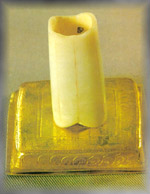 Tradition
relates that finger bones of the Buddha had been sent from India to China by
the great emperor Ashoka [3rd cent BCE]. A reformed conqueror, his conversion
to Buddhism was of great historic importance. He encouraged the new faith throughout
his lands as well as the wide distribution of Buddha's relics. Relics, [sarira]
in the form of bones were usually enshrined beneath a stupa. In India the stupa,
which pre-dated Buddhism, was a large hemispherical mound with a central mast
crowned by canopies. In China, the presence of Han dynasty multi-storyed watch
towers probably influenced the development of the stupa, which transformed itself
to become the Chinese pagoda.
Tradition
relates that finger bones of the Buddha had been sent from India to China by
the great emperor Ashoka [3rd cent BCE]. A reformed conqueror, his conversion
to Buddhism was of great historic importance. He encouraged the new faith throughout
his lands as well as the wide distribution of Buddha's relics. Relics, [sarira]
in the form of bones were usually enshrined beneath a stupa. In India the stupa,
which pre-dated Buddhism, was a large hemispherical mound with a central mast
crowned by canopies. In China, the presence of Han dynasty multi-storyed watch
towers probably influenced the development of the stupa, which transformed itself
to become the Chinese pagoda.
The temple of Famen was one of only four in all China which were supposed to
contain actual relics of the historical Buddha and it is the only one where
the actual structure and the relics have survived to the present day.
The earliest temple
ca 160 CE
Records state that here, during the reign of Emperors Huan and Ling of the
Eastern Han [r.149 - 189 CE] , that a stupa with a crypt was built to shelter
the relics of Lord Buddha. The archeological record does show this original
structure which was probably assimulated into later construction during the
Tang dynasty.
Some two hundred years later, the Wei dynasty secured the place of Famen Si
. In 495 CE the Wei ruler opened the crypt so that he could place sacrifical
offerings to show his respect. From that time the fame of the temple spread
far and wide.
Tang dynasty support for
Famen Si
However, it was during the Tang dynasty (618 - 907 CE) that Famen Si reached
its height of importance. Because of its relics and because of its proximity
to the royal capital at Chang-an [Xian]). In 625 it was formally renamed Famen
Si [Temple of the Gate of the Law].
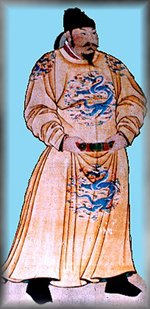 It
was Emperor Li Shimin [Taizong r.626 - 649] who ordered the crypt to be opened
so that the relics could be worshipped. Following Taizong's rule, seven emperors
and one empress, the flamboyant Empress Wu, opened the crypt every thirty years.
During each opening it is likely the rulers placed treasures within the crypt
to honour the precious relics. So, when last sealed in 874 the crypt contained
objects of the very highest value and quality that Tang artisans could create.
It
was Emperor Li Shimin [Taizong r.626 - 649] who ordered the crypt to be opened
so that the relics could be worshipped. Following Taizong's rule, seven emperors
and one empress, the flamboyant Empress Wu, opened the crypt every thirty years.
During each opening it is likely the rulers placed treasures within the crypt
to honour the precious relics. So, when last sealed in 874 the crypt contained
objects of the very highest value and quality that Tang artisans could create.
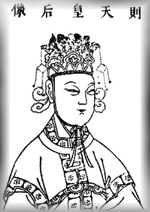
During most of the recorded openings, the relics were brought in ceremonial
procession to the capital. The distance to Chang-an [Xian] is 120 kilometres,
so the journey must have lasted several days. The relic, decorated with gold,
jade, silk and jewellery, would be transported in imperial carriages. There
was considerable religious frenzy as individuals competed to donate the most
precious items to monasteries and to make offerings to the relic. Gold and jade
decorated piles of earth built to form incense posts along the route.
Such spectacularly public devotion would have been recognised as bringing great
merit to the donors as well as being an enormously popular public spectacle.
However, there was tremendous cost to individuals and the state as monasteries
and clergy were exempt from taxation; and wealth in the form of gold, silver
and bronze images was sequestered in the temples.
During the later Tang, anti-Buddhist sentiment gradually developed and with
growing political and economic instability the Chinese generally began to reject
their openess to things foreign. In 819 the scholar Han Yu wrote a particularly
pungent criticism which unconsciously says a lot about his Confucian mindset:
Now the Buddha was of barbarian origin, His language differed from
Chinese speech; his clothes were of a different cut; his mouth did not pronounce
the prescribed words of the Former Kings, his body was not clad in the garments
prescribed by the Former Kings. ..... now that he has long been dead, is it
fitting that his decayed and rotten bones, his ill-omened and filthy remains,
should be allowed to enter in the forbidden precincts of the Palace?... I pray
that Your Majesty will turn this bone over to the officials that it may be cast
into water or fire, cutting off for all time the root and so dispelling the
suspicions of the empire and preventing the befuddlement of later generations.
Han's criticism enraged the emperor Xianzong (r 805-820). As a supporter of
Buddhism he was particularly miffed by the assertion that all dynasties which
supported Buddhism were short-lived. (which was factually incorrect!) He ordered
the death of Han Yu but was persuaded to commute this to demotion and expulsion
to a remote province.
It was not for another twenty years that suppression of Buddhism was undertaken
and then only briefly. By the middle 9th century however, although Buddhism
remained the main religion of China its period of greatest influence and popularity
was over.
In 874 during the reign of Emperor Xizong, the practice of opening the Famen
tomb stopped. Engraved stone tablets were placed to record this last sealing
and the crypt was closed.
Collective memory loss
and re-discovery
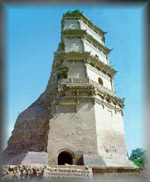 For
centuries, Famen Si remained a notable site but the presence of the relics,
the public worship by imperial rulers and their associated treasure faded from
memory. During the Ming dynasty, seven hundred years later, its importance was
acknowledged by constructing a thirteen storey brick pagoda. That was in 1579.
Earthquake damaged the pagoda in 1654 which was left un-repaired until 1939.
The passage of time and general state of dis-repair meant that the greater significance
of the site was forgotten, and this lapse of memory continued.
For
centuries, Famen Si remained a notable site but the presence of the relics,
the public worship by imperial rulers and their associated treasure faded from
memory. During the Ming dynasty, seven hundred years later, its importance was
acknowledged by constructing a thirteen storey brick pagoda. That was in 1579.
Earthquake damaged the pagoda in 1654 which was left un-repaired until 1939.
The passage of time and general state of dis-repair meant that the greater significance
of the site was forgotten, and this lapse of memory continued.
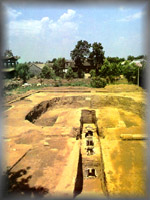 During
heavy rains in 1981 one side of the Ming pagoda collapsed again. Renovations
were started in 1987 and, quite by chance, a three-chambered underground palace
was discovered directly beneath the pagoda. Acheological investigation confirmed
a Tang construction with its treasures and relics, all of which had been undisturbed
and forgotten for 1,113 years.
During
heavy rains in 1981 one side of the Ming pagoda collapsed again. Renovations
were started in 1987 and, quite by chance, a three-chambered underground palace
was discovered directly beneath the pagoda. Acheological investigation confirmed
a Tang construction with its treasures and relics, all of which had been undisturbed
and forgotten for 1,113 years.
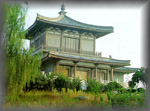 The rarity and quality of these treasures and the presence of sarira make
the re-discovery of Famen Si an acheological milestone.
The rarity and quality of these treasures and the presence of sarira make
the re-discovery of Famen Si an acheological milestone.
The underground building
 The
structure of the underground palace reflected the form of Tang royal tombs.
It is orientated along a north-south axis and features a long sloping underground
approach corridor at the bottom of which is placed an epitaph tablet. Then
follows a level corridor and series of doors leading to three chambers. The
corridor and chambers cut through the foundations of the co-existing original
Tang square wooden pagoda. When the Ming constructed their octagonal pagoda
they cut into the Tang foundations but did not disturb the underlying older
structures as they were probably unaware of their presence.
The
structure of the underground palace reflected the form of Tang royal tombs.
It is orientated along a north-south axis and features a long sloping underground
approach corridor at the bottom of which is placed an epitaph tablet. Then
follows a level corridor and series of doors leading to three chambers. The
corridor and chambers cut through the foundations of the co-existing original
Tang square wooden pagoda. When the Ming constructed their octagonal pagoda
they cut into the Tang foundations but did not disturb the underlying older
structures as they were probably unaware of their presence.
And its contents
 The
Tang marked the high point in the manufacture and use of gold and silver ware.
Being easily convertible, much of gold and silver which existed during the heyday
of the empire must have been melted down. It is fortunate that the hoards which
were buried at times of rebellion and those in religious crypts such as Famen
si have been discovered undisturbed during the twentieth century.
The
Tang marked the high point in the manufacture and use of gold and silver ware.
Being easily convertible, much of gold and silver which existed during the heyday
of the empire must have been melted down. It is fortunate that the hoards which
were buried at times of rebellion and those in religious crypts such as Famen
si have been discovered undisturbed during the twentieth century.
The re-discovered Tang chambers at Famen contained a wealth of previously unknown
artefacts together with extensive documentary records. Most were contained in
the farthest, northern chamber and most were probably placed there during the
final closure in 874, as several of them bear dates to that effect.
the 'precious relics'
Four separate groups of sarira were found. Each was enclosed within
a series of small nested caskets.  The
caskets were of gold, or silver or jade, with many elaborately decorated. There
were three sets of 'decoy' caskets placed throughout the tomb. Each decoy set
was more sumptuous than that which contained the genuine sarira (a finger
bone). The authentic group of caskets was concealed in a hidden niche in the
rearmost chamber.
The
caskets were of gold, or silver or jade, with many elaborately decorated. There
were three sets of 'decoy' caskets placed throughout the tomb. Each decoy set
was more sumptuous than that which contained the genuine sarira (a finger
bone). The authentic group of caskets was concealed in a hidden niche in the
rearmost chamber.  The
other three sets are considered 'shadow bones', a device to protect the genuine
sarira from destruction in the event of Buddhist persecution.
The
other three sets are considered 'shadow bones', a device to protect the genuine
sarira from destruction in the event of Buddhist persecution.
The innermost casket in the genuine set is made of white jade. On its lid are
traces of gold-lined embroidered silk with which it had once been wrapped. Inside
there is a platform on which the Buddha's finger bone was placed.
other artefacts
The majority of artefacts discovered were offerings to the sarira.
As these were imperial gifts they include the finest quality gold, silver, porcelain,
glass, lacquer and stone wares, as well as textiles, jewellery and coins. A
stone tablet in the ante-chamber detailed most items:' A list
of Offerings, Gold and Silver Treasures and Costumes Accompanying the Genuine
Sarira.'
 Of
particular interest are the nineteen mi se [hidden colour]
celadon wares. The Famensi discover was the first time this glassy, translucent,
bluish-green glaze had been seen. This glaze was long known from the literary
record but what it looked like had remained obscure as their use was strictly
confined to the court. During the eighth century green pottery ware became more
popular than white. As tea drinking became more fashionable, connoisseurs concluded
that the green-glazed porcelains from Yue enhanced the colour of green tea and
its jade-like appearance was praised by poets. The presence of fourteen mise
wares at Famen highlighted the changed status of ceramic which only in Tang
times began to rival gold, silver and bronze as a prized material.
Of
particular interest are the nineteen mi se [hidden colour]
celadon wares. The Famensi discover was the first time this glassy, translucent,
bluish-green glaze had been seen. This glaze was long known from the literary
record but what it looked like had remained obscure as their use was strictly
confined to the court. During the eighth century green pottery ware became more
popular than white. As tea drinking became more fashionable, connoisseurs concluded
that the green-glazed porcelains from Yue enhanced the colour of green tea and
its jade-like appearance was praised by poets. The presence of fourteen mise
wares at Famen highlighted the changed status of ceramic which only in Tang
times began to rival gold, silver and bronze as a prized material.
 Outstanding
gold and silver work is shown in numerous items including a pair of gilded-silver
censers and numerous ceremonial caskets as well as a more mundane tea-mortar.
The latter is described as: 'A silver and gold tea grinder made
by the Wensi Hall in the tenth year of Xiantong era [869 CE] weighing twenty-nine
taels.'
Outstanding
gold and silver work is shown in numerous items including a pair of gilded-silver
censers and numerous ceremonial caskets as well as a more mundane tea-mortar.
The latter is described as: 'A silver and gold tea grinder made
by the Wensi Hall in the tenth year of Xiantong era [869 CE] weighing twenty-nine
taels.'
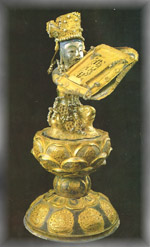 Persian
Gulf sea-water pearls adorn a gilded silver statue made in 871 to present the
finger bone for the Emperor Xizong to worship on his birthday. The relice was
placed between the lotus-leaf plates in the hands of this bodhisattva. An inscription
requests that: ..the holy life span be ten thousand Springs,
the holy one's branches have ten thousand leaves, the eight barbarians come
to submit, the four seas have no turbulence.
Persian
Gulf sea-water pearls adorn a gilded silver statue made in 871 to present the
finger bone for the Emperor Xizong to worship on his birthday. The relice was
placed between the lotus-leaf plates in the hands of this bodhisattva. An inscription
requests that: ..the holy life span be ten thousand Springs,
the holy one's branches have ten thousand leaves, the eight barbarians come
to submit, the four seas have no turbulence.
At age 37 Xizong (r 873-888) was a fervent Buddhist, raising military costs
and imposing special taxes to pay for Buddhist temples. It is said that having
seen this image he could happily die. Within two years he did indeed die, probably
as a result of ingestion of 'immortality' elixirs! In 873 Xixong was the last
emperor to bring the Buddha's finger bone back to the imperial palace in Chang'an.
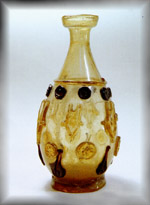 There
are several glass vessels from the Mediterranean, or Iran in the Famen deposit.
Chinese ceramic tradition was so skilled and so strong at this time that there
was little demand to develop a Chinese glassware industry. Imported wares were
more translucent and less brittle than Chinese glass.Even in the Tang dynasty,
utensils of fine clear glass from abroad were still consider exotic treasures:
There
are several glass vessels from the Mediterranean, or Iran in the Famen deposit.
Chinese ceramic tradition was so skilled and so strong at this time that there
was little demand to develop a Chinese glassware industry. Imported wares were
more translucent and less brittle than Chinese glass.Even in the Tang dynasty,
utensils of fine clear glass from abroad were still consider exotic treasures:
It is a jewel of Western countries, and is akin to jade and other stones. It
is born within the earth, and some say that it is water transformed after a
thousand years; still this is not necessarily so.

In addition to gold, silver and glass, a range of textile fragments from regions
outside China were also found. However, conditions in the crypt were not conducive
to good preservation of fabrics.
So numerous were the artefacts that many of the discoveries at Famen Si are
still to be described:
'Each piece of the relics in the crypt of the temple leaves us new
gaps beyond our knowledge and requires a long period of ten, twenty or even
dozens of years for specialists to fill them up.'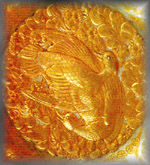
We, fortunately, do not have to wait that long to make our own assessment of
the glories contained in the Temple of the Gate of the Law.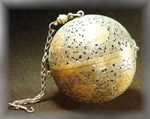
Modern Times
In the 1990s, with assistance from Japan, a group of tasteful small museum
buildings were built to display these treasures. Lying in a small compound,
directly accessible to the local village. Famen is two hours drive from Xi'an,
off the usual tourist trail, so the temple and its museum was mostly visited
by small numbers of interested Chinese, and by Japanese groups keen for a
first-hand experience of a Buddha relic. It was during, a quiet and dignified
place.
Most Recent Developments
In 2007 work started on a 'redevelopment' - massive even by Chinese standards.
Adjacent to the older buildings, a completely new temple was constructed.
At the end of a 1km paved accessway a pair of five-storey high meditating hands
sit above a similarly impressive golden statue of the Buddha. Along this accessway,
golden statues of attendant Boddhisatvas mimic the attendants of imperial
tombs. It is immense and breathtakingly grand.
And its depressing. A symbiosis of mammon and religion, that aspires to
awe and instead leaves an impression of Buddha's religion on an overdose
of speed. Despite the fact that this is definitely not the 'middle way'
one cannot help but be impressed and that is surely the intention of the
builders.
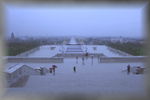 I
am impressed by the giganticness of it all and by the, perhaps cynical,
intention of the Chinese authorities that they are seen to be supporting
Buddhism. That tourists are coming in large numbers is very evident. The
1990s complex attracted perhaps a few hundreds each day, now there are many
thousands. One has to hope that a more subtle message will be imparted than
the one that is so obviously on show.
I
am impressed by the giganticness of it all and by the, perhaps cynical,
intention of the Chinese authorities that they are seen to be supporting
Buddhism. That tourists are coming in large numbers is very evident. The
1990s complex attracted perhaps a few hundreds each day, now there are many
thousands. One has to hope that a more subtle message will be imparted than
the one that is so obviously on show.
The new complex is walled off from the surrounding village so that villagers
can no longer provide snacks, food or simple curios to visiting pilgrims.
Those needs are now serviced in the glistening shops at the new entrance.
Famen Ci has been re-invented. The history, the sarira, and the
glorious works of Tang craftsmen are still there amidst the glitz. So -
go to Famen Ci it remains a great and special place.
Bibliography:
Peter Neville-Hadley, China, the Silk Routes, Cadogan, 1997.
Carol Michaelson, Gilded Dragons, Buried Treasures from China's Golden
Age, British Museum Press, 1999
Roderick Whitfield, The Significance of the Famensi Deposit, Orientations
Vol 21, No.5, May 1990, pages 84-86
Zhu Qixin, Buddhist Treasures from Famensi, The Recent Excavation of a
Tang Underground Palace, Orientations Vol 21, No.5, May 1990, pages 77-83
Precious Cultural Relics in the Crypt of Famen Temple, Shaanxi People's
Fine Art Publishing House, 1994.
Ten Major Museums of Shaanxi, Polyspring Co., 1994
top of page
site map
Copyright © Footprints Tours Ltd
Programming & design by Green Kiwi Ltd
Last updated:02 February, 2010
 As
you drive west from Xian you pass through fertile lands. This is part of the
great loess plateau-country of northern China created by the dust of
ground-down mountains far to the west. It has been blown for millenia to form
a layer of special soil, loess, in places hundreds of feet
thick.
As
you drive west from Xian you pass through fertile lands. This is part of the
great loess plateau-country of northern China created by the dust of
ground-down mountains far to the west. It has been blown for millenia to form
a layer of special soil, loess, in places hundreds of feet
thick.




















